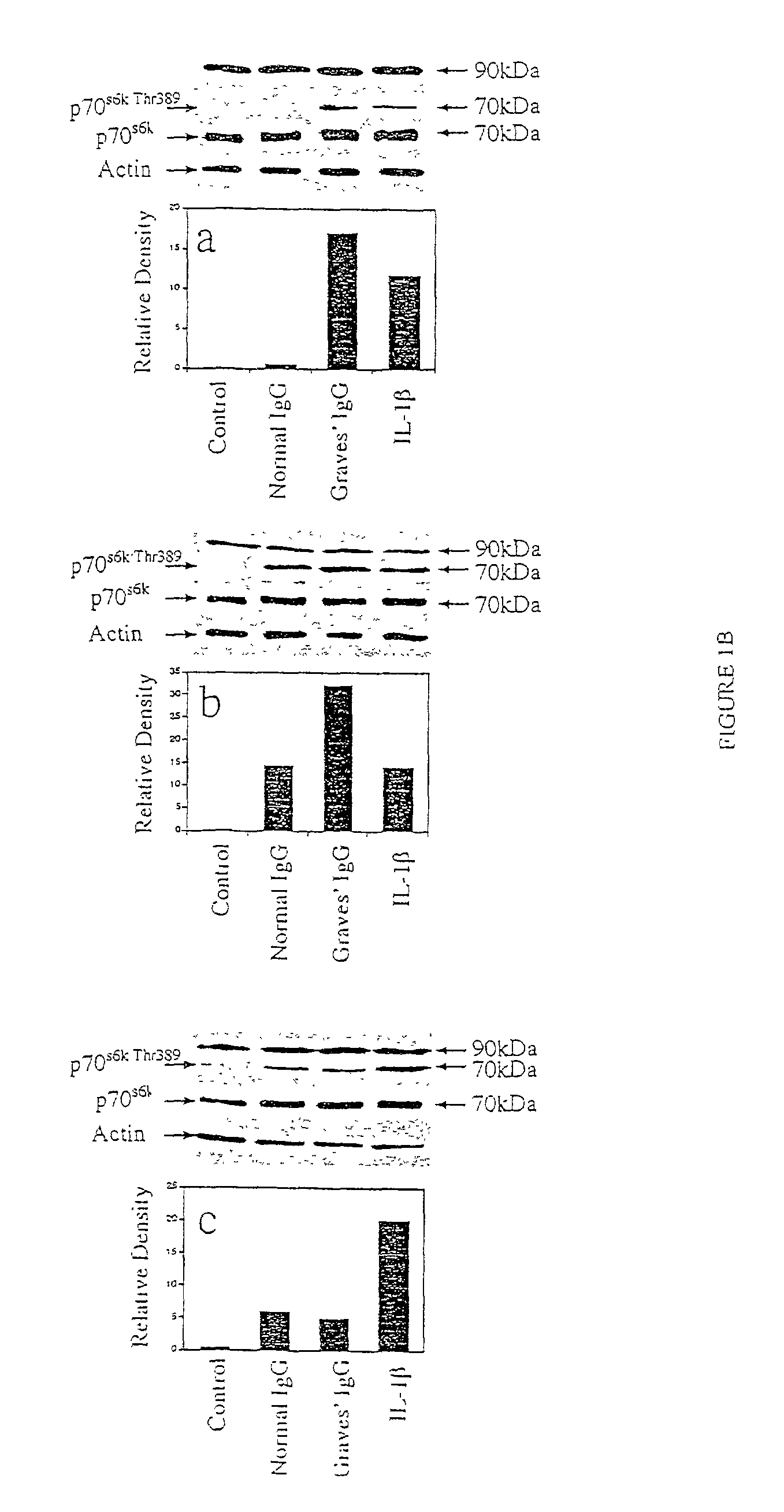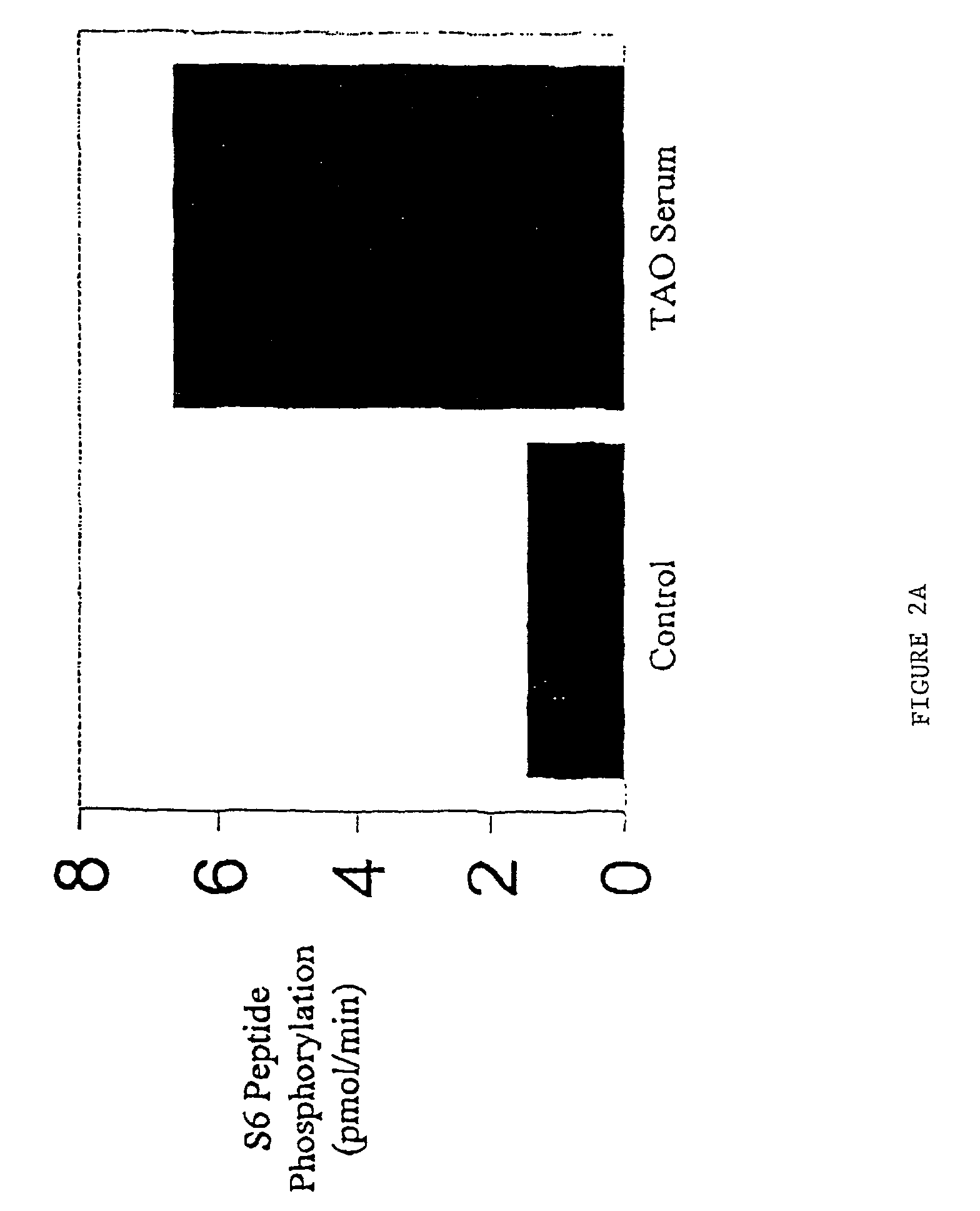Diagnosis and therapy of antibody-mediated inflammatory auto-immune disorders
a technology for autoimmune disorders and diagnosis, applied in the direction of immunoglobulins, instruments, peptides, etc., can solve the problems of poor understanding of the fundamental biochemical pathways and mechanisms underlying the disease process, lack of satisfactory therapies, and difficult clinical management of Graves' disease and rheumatoid arthritis
- Summary
- Abstract
- Description
- Claims
- Application Information
AI Technical Summary
Benefits of technology
Problems solved by technology
Method used
Image
Examples
example 1
Production of IL-16 and RANTES by Orbital Fibroblasts Upon Stimulation by TSI and Resultant Chemoattractant Activity
[0076]Orbital tissue in TAO becomes inflamed and infiltrated with lymphocytes and mast cells. Although the reason why immunologically competent cells are trafficked to the orbit is uncertain, applicants have presented preliminary evidence that the production of the CD4-specific chemoattractant, IL-16, is dramatically induced by TSI in TAO but not in normal orbital fibroblasts, (see FIG. 1). This experiment demonstrates that the expression of chemoattractants in the TAO orbit is the basis for T lymphocyte recruitment, and that the 50% of chemoattractive activity not accounted for by IL-16 is RANTES. This experiment demonstrates the role of IL-16 and RANTES in the lymphocyte migration activity emanating from fibroblasts by neutralization of these proteins with specific antibodies.
[0077]The general migration assay is described in detail in Sciaky, D., et al., “Cultured hu...
example 2
Demonstration of Identity between TSI and the IgG TAO Serum Factor which Activates TAO Ocular Fibroblasts
[0082]As described above, applicants have found that a component of TAO serum, binding to protein A, activates the synthesis and release of mature IL-16 and other chemoattractive activity from TAO orbital fibroblasts. This activity is manifested only in TAO but not normal orbital fibroblasts. This experiment demonstrates that the fibroblast-activating IgG belongs to the same subclass as classic TSI, which is an IgG1, and presents other evidence in support of the proposition that the component of TAO serum which activates TAO fibroblasts is, in fact, TSI.
[0083]First, sera was incubated with beads containing anti-heavy chain-specific antibodies, which verified that the immunoglobulin is IgG and not IgM. The adsorbed IgG was eluted either with high salt concentrations or low pH. Aliquots of the material were then passed over a series of IgG isotype-specific columns commercially avai...
example 3
Graves' Disease Specific-IgG Induction of IL-16 Expression and Release Involves a Rapamycin-Sensitive Pathway
[0086]As noted above, Graves' disease specific-IgG induces IL-16 and RANTES expression in fibroblasts by binding an epitope of the IGF-1 receptor on the cell surface. This reaction initiates protein synthesis through the activation of one or more signaling pathways. The FRAP / mTOR pathway and the activation of p70s6k, a serine / threonine kinase, play central roles in mediating the effects provoked by factors acting at the cell surface. A prominent characteristic of this pathway is its susceptibility to inhibition by the macrolide, rapamycin. This compound, at a concentration of 20 nM, can block ca 50% of the chemoattractive activity elicited by Graves'-IgG, coinciding with an attenuation of IL-16-dependent T cell migration (See Table I).
[0087]
TABLE IEffects of rapamycin and dexamethasone on IL-16 and RANTES synthesis and T lymphocyte migration activity provoked by IgG in fibrob...
PUM
| Property | Measurement | Unit |
|---|---|---|
| Fraction | aaaaa | aaaaa |
| Fraction | aaaaa | aaaaa |
| Fraction | aaaaa | aaaaa |
Abstract
Description
Claims
Application Information
 Login to View More
Login to View More - R&D
- Intellectual Property
- Life Sciences
- Materials
- Tech Scout
- Unparalleled Data Quality
- Higher Quality Content
- 60% Fewer Hallucinations
Browse by: Latest US Patents, China's latest patents, Technical Efficacy Thesaurus, Application Domain, Technology Topic, Popular Technical Reports.
© 2025 PatSnap. All rights reserved.Legal|Privacy policy|Modern Slavery Act Transparency Statement|Sitemap|About US| Contact US: help@patsnap.com



